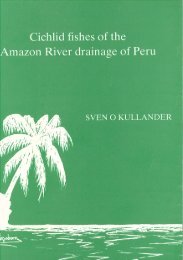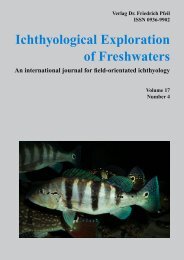Family Cichlidae (Cichlids) - Sven Kullander
Family Cichlidae (Cichlids) - Sven Kullander
Family Cichlidae (Cichlids) - Sven Kullander
You also want an ePaper? Increase the reach of your titles
YUMPU automatically turns print PDFs into web optimized ePapers that Google loves.
Check List of the Freshwater Fishes of South and Central America<br />
1989a), and Mesonauta (<strong>Kullander</strong> & Silfvergrip, 1991).<br />
The checklist herein recognizes 406 valid Neotropical cichlid species out of 635 nominal taxa. <strong>Kullander</strong> (1998) estimated<br />
that there are about ten undescribed North-Central American cichlid taxa and about 160 undescribed South American taxa.<br />
Numerous problems of species discrimination remain. Some of the most enigmatic cases include ‘Cichlasoma’ urophthalmus,<br />
of which Hubbs (1936) described numerous subspecies. Some of these taxa are certainly distinct species, but the<br />
status of highly localized subspecies from the Yucatán peninsula, which are based on one or very few specimens, remains a<br />
subject for revision. All these taxa are herein treated as valid for want of any better option.<br />
Another source of frustration concerns the generic assignment of Central American taxa, and a few South American taxa,<br />
which were excluded from the catch-all genus Cichlasoma by <strong>Kullander</strong> (1983a). Most of these are now recognized in<br />
well-diagnosed genera (<strong>Kullander</strong>, 1986, 1996b, <strong>Kullander</strong> & Hartel, 1997), but several are kept with the generic denomination<br />
‘Cichlasoma’ which is judged better than to include them in genera to which they certainly do not belong.<br />
On the whole it is not satisfactory to have one-third of the Neotropical cichlid fauna without a scientific name, illustrating a<br />
real problem with the more formalized procedure of naming species, but it could also signify a safeguarding against doubtful<br />
species. The current estimate of 450 South American taxa is based on species already represented in museum collections;<br />
it can be assumed that new collections will bring in many more new taxa.<br />
ACARICHTHYS<br />
Acarichthys Eigenmann, 1912: 500. Type species: Acara heckelii<br />
Müller & Troschel, 1849. Type by original designation. Gender:<br />
masculine.<br />
Acarichthys heckelii (Müller & Troschel, 1849)<br />
Acara heckelii Müller & Troschel in Schomburgk, 1849: 624.<br />
Type locality: Sümpfen der Savanne. No types known. Originally<br />
spelled as Acara Heckelii<br />
Geophagus Thayeri Steindachner, 1875: 108 [48], pl. 3 (fig. 2, 2a-<br />
2b). Type locality: Amazonenstrom bei Teffé, Villa bella, Obidos,<br />
Cudajas, Tonantins, Jatuarana, Ueranduba, Serpa, Rio Tapajos,<br />
R. Trombetas, R. negro, R. Xingu, see Hyanuary, José Assù,<br />
Saraca, Alexo und Lago maximo etc. Syntypes: (many) NMW<br />
74135 (1), 9249-9254 (5), NMW 17046-17048 (3), NMW<br />
17050-17051 (2), NMW 17052-17054 (3), NMW 17055-17057<br />
(3), NMW 17058-17060 (2), NMW 17061-17064 (3), NMW<br />
17066 (1), NMW 17067-17070 (4), NMW 17101-17102 (1),<br />
NMW 17103-17110 (several), NMW 17119-17125 (several),<br />
NMW 23819-23821 (3), NMW 24012 (1), NMW 24094-24095<br />
(2), 24096 (7), NMW 24105-24106 (2), NMW 24107-24108 (2),<br />
NMW 24109-24110 (2), NMW 24111-24114 (3), NMW 24115-<br />
24116 (2), NMW 24133-24138 (6), ZSM 27335 (1).<br />
Acara subocularis Cope, 1878: 696. Type locality: [Peruvian<br />
Amazon]. Holotype: ANSP 21233 (missing).<br />
Maximum length: 13.4 cm SL<br />
Distribution: South America: Along mainstream Amazon River in<br />
Peru, Colombia, and Brazil, including lower parts of the Putumayo,<br />
Trombetas, Negro, and Xingu Rivers; lower Tocantins<br />
River, and Capim River; Branco River (Amazon basin) in Brazil<br />
and Guyana, and the Essequibo River in Guyana.<br />
Countries: Brazil, Colombia, Guyana, Peru<br />
Remarks and references: Redescription based on Peruvian material<br />
by <strong>Kullander</strong> (1986: 134).<br />
ACARONIA<br />
Acara (Acaropsis) Steindachner, 1875: 80. Type species: Acara<br />
nassa Heckel, 1840. Type by monotypy. Gender: feminine. Preoccupied<br />
by Acaropsis Moquin-Tandon 1859 in Arachnida.<br />
Acaronia Myers, 1940: 170. Type species: Acara nassa Heckel,<br />
1840. Type by being a replacement name. Gender: feminine. Replacement<br />
for Acaropsis Steindachner 1875, preoccupied by<br />
Acaropsis Moquin-Tandon 1859 in Arachnida.<br />
Acaronia nassa (Heckel, 1840)<br />
Acara nassa Heckel, 1840: 353. Type locality: Rio-Guaporé.<br />
Syntypes: NMW 10538-40 (3), NMW 16185 (1), NMW uncat.<br />
(1).<br />
Acara unicolor Heckel, 1840: 357, pl. 30 (fig. 25). Type locality:<br />
Barra do Rio-negro. Syntypes: NMW 33347-33348 (2).<br />
Acara cognatus Heckel, 1840: 356. Type locality: Barra do Rionegro.<br />
Holotype: NMW 33619.<br />
Centrarchus ? rostratus Jardine, 1843: 163, pl. 15. Type locality:<br />
Rio Negro. No types known.<br />
Apistogramma ambloplitoides Fowler, 1940: 281, fig. 63. Type<br />
locality: Ucayali River basin, Contamana, Peru. Holotype: ANSP<br />
68681.<br />
Maximum length: 15.4 cm SL<br />
Distribution: South America: Amazonas lowlands in Peru, Brazil,<br />
and Colombia, Bolivian Amazon basin, middle and lower Negro<br />
River, Branco River, also Amapá State, the Oyapock drainage in<br />
French Guiana, and the Essequibo drainage in Guyana.<br />
Countries: Bolivia, Brazil, Colombia, French Guiana, Guyana,<br />
Peru<br />
Remarks and references: Redescription based on Peruvian material<br />
in <strong>Kullander</strong> (1986: 79), distinguishing characters and synonymy<br />
discussed in <strong>Kullander</strong> (1989b).<br />
Common names: Krobié (French Guiana), Paya (French Guiana)<br />
Acaronia vultuosa <strong>Kullander</strong>, 1989<br />
Acaronia vultuosa <strong>Kullander</strong>, 1989b: 447, fig. 1. Type locality:<br />
Venezuela, Terr. Federal Amazonas, Departamento Ature, small<br />
drying backwater pool off road from El Burro to Puerto Ayacucho,<br />
approximately 05°47’N, 67°29’W. Holotype: MBUCV-<br />
V 17714.<br />
Maximum length: 12.2 cm SL<br />
Distribution: South America: Orinoco River basin in Colombia<br />
and Venezuela, including the Casiquiare, Inírida, Caura, Vichada<br />
Rivers; upper Negro River in Brazil and Venezuela (San Carlos,<br />
Ererê River and Tamaquaré Island).<br />
Countries: Brazil, Colombia, Venezuela<br />
AEQUIDENS<br />
Aequidens Eigenmann & Bray, 1894: 616. Type species: Acara<br />
tetramerus Heckel, 1840. Type by original designation. Gender:<br />
masculine. Originally Astronotus (Aequidens).<br />
Aequidens biseriatus (Regan, 1913)<br />
Cichlosoma (Aequidens) biseriatum Regan, 1913b: 471. Type<br />
locality: Rio Condoto. Syntypes: BMNH 1913.10.1.80-88 (7 of<br />
8).<br />
Maximum length: 8 cm TL<br />
Distribution: South America: Atrato, San Juan and Baudó River<br />
basins.<br />
Countries: Colombia<br />
Aequidens chimantanus Inger, 1956<br />
607




